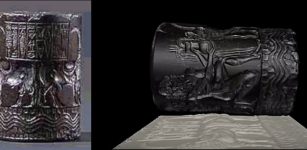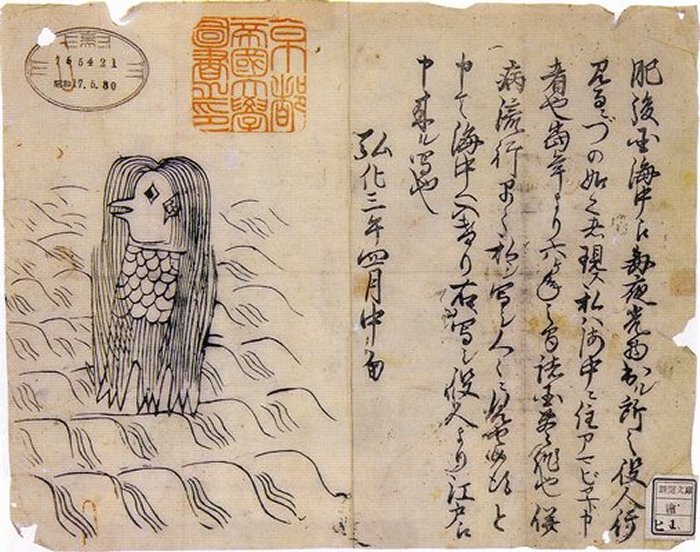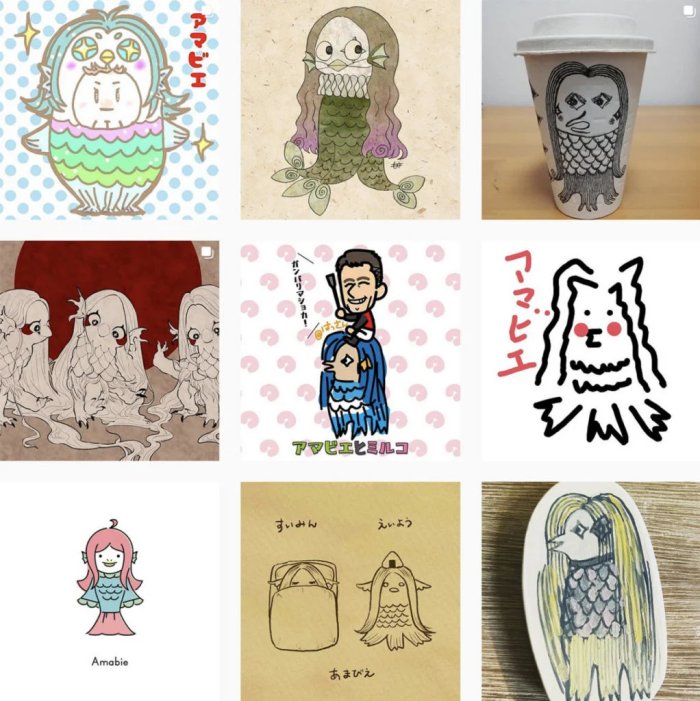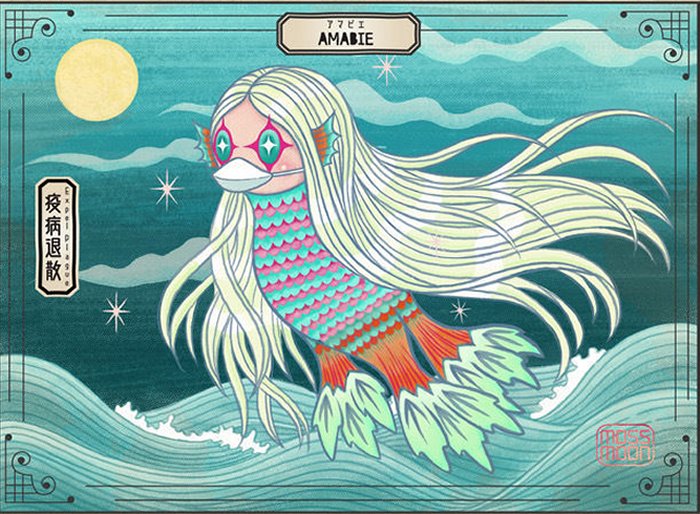Yokai Amabie – Protective Ancient Spirit That Can Ward Off Epidemics
Ellen Lloyd - AncientPages.com - Those who are not familiar with Japanese folklore have probably never heard about Amabie, but this little creature reminds us of the difficulties we must endure because of the coronavirus outbreak.
In Japanese mythology we encounter various types of Yokai, and one of them is known as Amabie. A Yokai is basically supernatural beings that dwell in the borderlands and in spaces, which are located “in-between”.
An amabie. Wood-block print, late Edo period. Credit: Public Domain
“Yokai begin where language ends. Mysterious sounds. Lights flitting through the graveyard. A flood that destroys one village and leaves another unscathed. A feeling that something is watching you in the darkness. How do we speak of things that are ungraspable, anomalous? What words can we use to signify things that evade established categories and seemingly refuse to conform to the laws of nature?
In Japan, as elsewhere, inexplicable occurrences and supernatural creatures have been part of the cultural imagination for as long as history has been recorded.
Broadly speaking, these diverse mysterious phenomena and weird “things” have come to be called yokai. In a sense, yokai is nothing more than a convenient label to indicate a whole range of otherwise ineffable experiences that might, in English, be translated with the words spirits, goblins, phantoms, specters, sprites, shape-shifters, demons, fantastic beings, numinous occurrences, the supernatural, and perhaps most commonly today, monsters.
This wide variety of possible translations speaks to the open-endedness of the word and hints at the many different ideas and nuances associated with it,” Michael Dylan Foster writes in his book The Book of Yokai: Mysterious Creatures of Japanese Folklore.
Amabie is a Japanese mermaid-like creature with long hair, a beak, and 3 legs.
According to an Edo-period tile block print dated 1846, Amabie appeared off the coast of Kumamoto, Japan. Amabie predicted a bountiful harvest for the next six years, but that’s not all.
This mythical Yokai came to humans with a message, giving people advice in case of an epidemic.
Amabie said - “Good harvest will continue for six years from the current year if disease spreads, show a picture of me to those who fall ill and they will be cured.” Afterward, Amabie returned to the sea, but the memory of the enigmatic creature has been kept alive.
via This is Colossal
Currently many are sharing drawings of Amabie on social media in hopes of repelling disease.
Since Yokai are believed to be creatures with supernatural powers, many artists in Japan and other countries are now turning to this protective ancient spirit that is said to ward off epidemics. By drawing images of Amabie, people are showing support against the coronavirus.
In accounts of Amabie, it is sometimes said that the image itself can ward off the epidemic,” Jack Stoneman, a Professor of Asian and Near Eastern Languages at Brigham Young University said.
“This is not unusual in Japanese cultural history—images as talismans.”
When Kaori Hamura Long was at home with flu-like symptoms she drew Amabie wearing a mask. Credit: Kaori Hamura Long
The fact that we can find images of Amabie on social media shouldn’t be interpreted as a religious call for help. As the coronavirus pandemic continues to take its toll, Amabie is here to show us that we are not alone. These wonderful images created by artists all over the world show solidarity. In times like these, it’s more important than ever to stand united.
Drawing an image of Amabie will not help us overcome the coronavirus outbreak, but it may give us some comfort and inner peace.
Written by Ellen Lloyd – AncientPages.com
Copyright © AncientPages.com & Ellen Lloyd All rights reserved. This material may not be published, broadcast, rewritten or redistributed in whole or part without the express written permission of AncientPages.com and Ellen Lloyd
More From Ancient Pages
-
 A 900-Year-Old Crusader Sword Discovered Off The HaCarmel Coast, Israel
Archaeology | Oct 20, 2021
A 900-Year-Old Crusader Sword Discovered Off The HaCarmel Coast, Israel
Archaeology | Oct 20, 2021 -
 Huge, Ancient Underground City Filled With Artifacts Discovered In Mardin, Turkey
Archaeology | Apr 20, 2022
Huge, Ancient Underground City Filled With Artifacts Discovered In Mardin, Turkey
Archaeology | Apr 20, 2022 -
 Man Following Sinister Green Light Discovers Mysterious Ancient Artifacts And Strange Mummies In Secret Cave
Ancient Mysteries | Feb 18, 2025
Man Following Sinister Green Light Discovers Mysterious Ancient Artifacts And Strange Mummies In Secret Cave
Ancient Mysteries | Feb 18, 2025 -
 Mysterious Ancestor Of All Mammals Identified Through Genome Reconstruction
Archaeology | Sep 30, 2022
Mysterious Ancestor Of All Mammals Identified Through Genome Reconstruction
Archaeology | Sep 30, 2022 -
 Unorthodox Ancient ‘Out-Of-This World’ Carvings Were Found And Destroyed – Discovery – Part 1
Ancient Mysteries | Aug 10, 2020
Unorthodox Ancient ‘Out-Of-This World’ Carvings Were Found And Destroyed – Discovery – Part 1
Ancient Mysteries | Aug 10, 2020 -
 Drought Was Not The Reason Cahokia, North America’s First City Was Suddenly Abandoned – New Study
Archaeology | Jul 4, 2024
Drought Was Not The Reason Cahokia, North America’s First City Was Suddenly Abandoned – New Study
Archaeology | Jul 4, 2024 -
 Mysterious Ancient Rulers With Elongated Skulls – Who Were They Really?
Ancient Mysteries | May 19, 2015
Mysterious Ancient Rulers With Elongated Skulls – Who Were They Really?
Ancient Mysteries | May 19, 2015 -
 On This Day In History: Samurai Final Battle of Shiroyama Was Fought – On Sep 24, 1877
News | Sep 24, 2016
On This Day In History: Samurai Final Battle of Shiroyama Was Fought – On Sep 24, 1877
News | Sep 24, 2016 -
 On This Day In History: Battle Of Dormans Was Fought – On October 10, 1575
News | Oct 10, 2016
On This Day In History: Battle Of Dormans Was Fought – On October 10, 1575
News | Oct 10, 2016 -
 Why Is The Hungry Ghost Festival Celebrated In August?
Ancient Traditions And Customs | Aug 12, 2019
Why Is The Hungry Ghost Festival Celebrated In August?
Ancient Traditions And Customs | Aug 12, 2019 -
 Mahabharata And Ramayana – Two Major Sanskrit Epics Of Ancient India
Featured Stories | Jul 12, 2021
Mahabharata And Ramayana – Two Major Sanskrit Epics Of Ancient India
Featured Stories | Jul 12, 2021 -
 Sharkalishharri Cylinder Seal From The Fifth King Akkad Dynasty
Artifacts | Feb 14, 2016
Sharkalishharri Cylinder Seal From The Fifth King Akkad Dynasty
Artifacts | Feb 14, 2016 -
 Naglfar Nail-Ship Carries Demonic Forces To Ragnarok In Norse Beliefs
Featured Stories | Aug 10, 2020
Naglfar Nail-Ship Carries Demonic Forces To Ragnarok In Norse Beliefs
Featured Stories | Aug 10, 2020 -
 Children’s Toys Among Roman-Era Artifacts Unearthed At Ancient City Of Beçin Turkey
Artifacts | Oct 14, 2020
Children’s Toys Among Roman-Era Artifacts Unearthed At Ancient City Of Beçin Turkey
Artifacts | Oct 14, 2020 -
 King Menelaus Of Sparta: Husband Of Helen Of Troy And Key Figure In The Trojan War
Featured Stories | May 27, 2020
King Menelaus Of Sparta: Husband Of Helen Of Troy And Key Figure In The Trojan War
Featured Stories | May 27, 2020 -
 Early Expansion Of Homo sapiens: Underwater Caves Give New Clues About Sicily’s First Residents
Underwater Discoveries | Oct 15, 2024
Early Expansion Of Homo sapiens: Underwater Caves Give New Clues About Sicily’s First Residents
Underwater Discoveries | Oct 15, 2024 -
 Mischievous Irish Pooka, Shapeshifter And Prankster Has Its Counterparts
Featured Stories | Mar 15, 2018
Mischievous Irish Pooka, Shapeshifter And Prankster Has Its Counterparts
Featured Stories | Mar 15, 2018 -
 Impressive Column Of Emperor Marcus Aurelius – War Monument From Ancient Rome
Featured Stories | Jul 6, 2017
Impressive Column Of Emperor Marcus Aurelius – War Monument From Ancient Rome
Featured Stories | Jul 6, 2017 -
 Was Biblical King David Unknowingly Part Of A Secret Master Plan?
Ancient Mysteries | Jul 1, 2021
Was Biblical King David Unknowingly Part Of A Secret Master Plan?
Ancient Mysteries | Jul 1, 2021 -
 Perforated Shells Were Used By Humans 120,000 Years Ago
Archaeology | Jul 10, 2020
Perforated Shells Were Used By Humans 120,000 Years Ago
Archaeology | Jul 10, 2020



